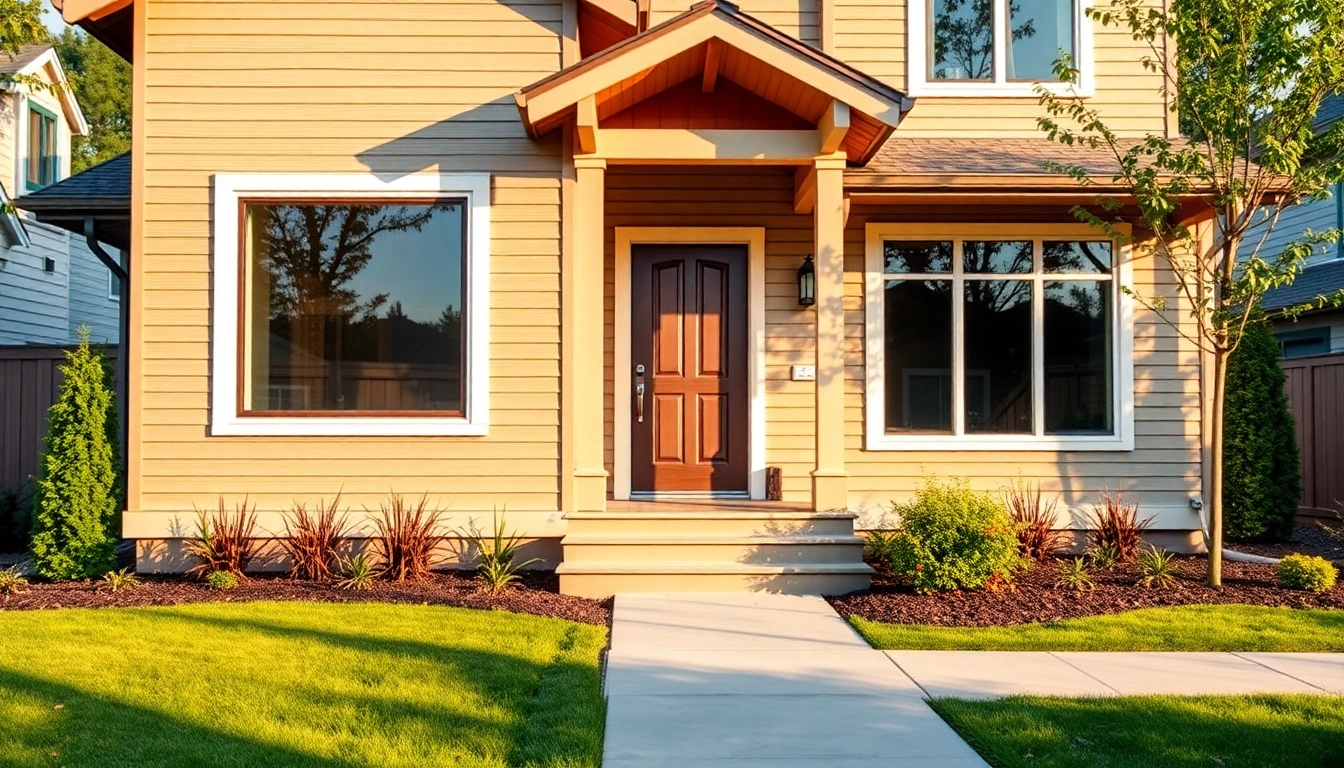Understanding Exterior Renovations
What Are Exterior Renovations?
Exterior renovations encompass a wide range of home improvement projects focused on enhancing the outer appearance and functionality of a property. These renovations can include anything from updating siding, roofing, and windows to adding decks, porches, or landscaping elements. The primary goal of exterior renovations is to improve curb appeal, increase property value, and ensure the home’s structural integrity is maintained. Homeowners typically undertake these projects to refresh an aging home, respond to environmental wear, or simply to enjoy a more aesthetically pleasing environment.
Benefits of Investing in Exterior Renovations
Investing in exterior renovations offers a multitude of benefits:
- Increased Property Value: Updated exteriors can significantly boost the market value of a home. Many buyers look for properties with modern and well-maintained exteriors.
- Enhanced Curb Appeal: An attractive exterior can leave a lasting impression, making your property stand out in the neighborhood.
- Energy Efficiency: Renovations such as new windows or insulation can lead to significant energy savings, impacting monthly utility bills.
- Improved Safety and Structural Integrity: Exterior renovations often address wear and tear that could lead to safety issues if left untreated.
- Personal Satisfaction: A refreshed exterior can enhance a homeowner’s pride in their property and contribute to their quality of life.
Common Types of Exterior Renovations
Several common types of exterior renovations can be pursued to achieve the desired changes in your home:
- Siding Replacement: Vinyl, wood, or fiber-cement siding can be used to enhance the look of your home while protecting it from the elements.
- Roofing: Replacing or repairing roofs with durable materials can extend the life of your home and improve energy efficiency.
- Window and Door Upgrades: New energy-efficient windows and stylish doors can enhance aesthetics while reducing energy costs.
- Landscaping: Incorporating trees, shrubs, flower beds, and pathways can transform the external environment into a vibrant, welcoming atmosphere.
- Outdoor Living Spaces: Building decks, patios, or outdoor kitchens can create functional spaces for relaxation and entertainment.
Planning Your Exterior Renovation Project
Setting Your Renovation Goals
The first step in any renovation project is to clearly define your goals. Determine what you wish to achieve with your exterior renovations, such as improving curb appeal, addressing structural concerns, or increasing living space. It’s essential to prioritize your goals as it helps in making informed decisions throughout the planning process and keeps the project aligned with your overall vision.
Budgeting for Exterior Renovations
Creating a dedicated budget is critical for successful exterior renovations. Here’s how to budget effectively:
- Assess Renovation Costs: Research potential costs for the renovations you’re considering. Typical exterior projects can range from $5,000 to over $30,000 depending on the scope of work.
- Include Hidden Costs: Be sure to account for permits, inspections, and potential unexpected expenses that may arise during the renovation.
- Prioritize Projects: If on a tight budget, prioritize which renovations need immediate attention and which can be postponed.
Selecting the Right Contractors
Your choice of contractors can make or break your renovation project. Seek professionals who specialize in exterior renovations with a proven track record of quality work. Always check references and view completed projects. When interviewing potential contractors, ask about their vision for your space, timelines, and payment structures to ensure alignment with your expectations.
Design Trends in Exterior Renovations
Popular Styles and Materials
When it comes to exterior renovations, certain styles and materials are gaining popularity:
- Minimalist Architecture: Clean lines and simple designs are trending, focusing on maximizing space and natural light.
- Sustainable Materials: Eco-friendly materials, such as recycled wood and energy-efficient windows, are becoming increasingly popular among environmentally conscious homeowners.
- Classic Designs: Traditional features like shutters and detailed moldings still capture attention, creating a timeless aesthetic.
Incorporating Sustainable Practices
Sustainability is a significant trend in exterior renovations. Here are some practices to consider:
- Energy-Efficient Windows and Doors: Using Energy Star-rated products can drastically reduce heating and cooling costs.
- Green Roofing: Implementing rooftops with vegetation can help absorb rainwater, lower indoor temperatures, and provide additional insulation.
- Rainwater Harvesting Systems: Incorporating systems to collect and reuse rainwater can minimize the environmental footprint of landscaping.
Color Schemes That Stand Out
Choosing the right colors for your home’s exterior can transform its appearance significantly. When selecting color schemes, consider the following:
- Bold Contrasts: Using contrasting colors can make architectural details pop, adding visual interest.
- Nature-Inspired Palettes: Colors that reflect natural surroundings, such as earthy tones, greens, and blues, create a harmonious connection to the environment.
- Timeless Neutrals: Classic neutrals offer versatility and appeal, ensuring your home remains stylish over time.
Executing Your Exterior Renovation
Project Management Tips
Effective project management is crucial for a smooth renovation experience. Consider the following tips:
- Develop a Detailed Timeline: Create a realistic timeline that outlines each phase of the project, including deadlines for contractor work, inspections, and final walkthroughs.
- Maintain Open Communication: Regular check-ins with your contractor and team can help address potential issues before they become significant problems.
- Stay Flexible: Be prepared for unexpected delays or challenges, and adapt your plans accordingly to keep the project moving forward.
Ensuring Compliance with Local Regulations
Before commencing any renovation work, familiarize yourself with local building codes and zoning regulations. Permits may be required for roofing, siding, and structural changes, and failure to obtain these can lead to fines or mandated removal of completed work. Inform your contractors of the necessary compliance requirements to ensure a seamless process.
Timelines and What to Expect
The timeline for exterior renovations can vary based on the complexity of the project. Here are some general timelines for common renovations:
- Siding Replacement: 1-2 weeks
- Roofing: 1-3 days to a couple of weeks
- Window Replacement: 1-4 weeks depending on the number of windows
- Landscaping Projects: 1-2 weeks
Being aware of these timeframes can help set realistic expectations for completion and allow for proper planning around your daily life.
Maintenance After Your Exterior Renovation
Essential Maintenance Tips
Post-renovation maintenance is vital to preserving the investment made in your home. Consider these maintenance strategies:
- Regular Inspections: Inspect roofs, siding, and windows at least twice a year for any signs of wear, leakage, or damage.
- Cleaning: Keep exteriors clean using appropriate cleaning methods specific to your materials, avoiding harmful chemicals that can cause degradation.
- Maintenance of Outdoor Spaces: Regularly maintain gardens, lawns, and any hardscapes to prevent overgrowth and maintain aesthetic appeal.
Signs of Damage to Watch For
Early detection of issues can save homeowners substantial repair costs. Watch for:
- Discoloration or Peeling Paint: This can indicate moisture issues or damage to the underlying material.
- Crumbling Siding or Brick: Structural integrity might be compromised; immediate attention is required.
- Visible Gaps or Cracks: Gaps around windows and doors can lead to increased energy costs and require caulking or insulation.
When to Call Professionals for Repair
While homeowners can DIY many issues, certain signs warrant professional attention:
- Staining or Mold Growth: If found, this could indicate underlying moisture issues that need a trained eye.
- Extensive Damage: Areas severely affected by rot, pests, or structural failure should be assessed by a professional to determine the best repair methods.
- Complex Issues: Complicated repairs such as roofing or siding fixes that involve high risks are best left to experienced contractors.


